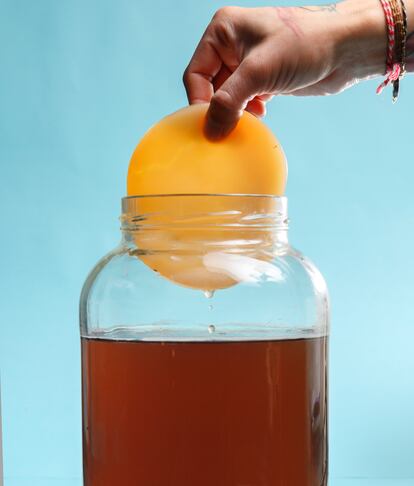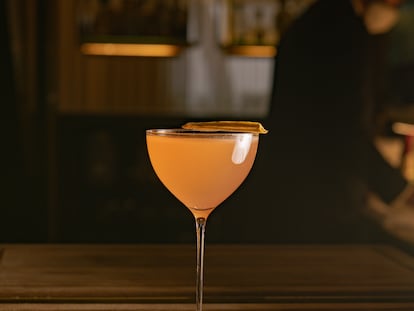Kombucha is not what it appears to be: How to avoid being deceived
A lack of regulation and a fashion for drinking this fermented tea has led many brands to sell vinegary soft drinks as if they were the real deal

“There’s not much difference between some of those on the market and a Coca-Cola,” says Javier Maeztu, a nutritionist and kombucha fermentor. The trendy drink exists in a legal vacuum in which anything goes. The food industry has seen a boom in this supposedly healthy alternative to sugary soft drinks, and has taken advantage of the lack of regulation to bring soft drinks and other ultra-processed products to the market that have little to do with the age-old formula. Under this umbrella, tea bags are marketed as infusions, as are powders to dissolve in water, and vinegars with sweeteners and carbon dioxide. They all claim to be kombucha when in reality they are not.
To a large extent, the healthy label that accompanies the drink is what is behind this fever. The bacteria and yeasts that transform fresh foods into fermented foods can have probiotic effects. And although there have been few studies carried out in this regard, there are certain indications that seem to confirm that consuming kombucha helps control glucose levels in patients with type 2 diabetes, such as those shown in a study published in the journal Frontiers of nutrition this summer. These claims have attracted an audience that, in search of these benefits, has rushed to the shelves of supermarkets, herbalists, and online stores to purchase the drink.
But, to get these benefits, you first have to know what exactly kombucha is, and there is no regulation in the world that states what the drink is and what it is not. Without regulation, it is quite difficult for the consumer to find what they are really looking for. However, it seems that there is a certain consensus among experts about the parameters that a drink must follow in order to be called kombucha. They have been set out by the Kombucha International Brewers (KIB) Code of Practice, based in California. The organization sets the values of what a real kombucha available for purchase is. However, its link with the industry, which is widespread in the United States, has caused this code of good practices to become more lax over time. In its latest version, it has come to allow the addition of carbon dioxide, flavorings, vitamins, and colorants, among other ingredients. If we refer to the base recipe, kombucha should only contain four: tea, sugar, water, and SCOBY (Symbiotic Culture of Bacteria and Yeast).
For Robert Ruiz, an expert in fermentation and distillates and co-founder of LOV Ferments — a company specializing in fermented beverages and traditional alcoholic beverages —, this lack of regulation can be viewed as a creative niche or as an opportunity for large industry to also infiltrate this field. This creative versatility is what has led many chefs and beverage designers to experiment and use kombucha scobys to ferment other liquids that are not tea. These experiments have gotten interesting results with a lot of gastronomic potential, something that Ruiz has experienced and teaches students in his courses.

The production of kombucha requires between three and four weeks for fermentation to be correct, which is time that the industry cannot afford. Mass manufacturing often cheats to speed up processes, resulting in products that share organoleptic characteristics such as light carbonation and acidity, but are not actually what would be traditionally understood as kombucha and deviate from the quality standards set by the KIB.
“Many of the brands on the market are actually vinegars to which sweeteners and sparkling water have been added and can be sold as calorie-free foods,” Ruiz complains. Among the most used compounds is Manna-K, a super-concentrated kombucha vinegar that promises to “reduce production times from a month to a day,” but which has lost the microscopic life it had at the beginning. It is an ingredient widely used today by startups that want to compete in this promising market. It allows them to skip steps in addition to resulting in much more stable drinks suitable for large distribution, but which do not differ much from soft drinks full of gas and sweeteners. Another very common practice is to add bacteria from the bacillus group to pasteurized kombuchas in order to sell them as foods with probiotics, although these microorganisms are typical of other fermentations.
How to distinguish a good kombucha
A first trick that will allow you to distinguish a good kombucha from a bad one is its place in the supermarket. Since they contain live bacteria, it is best to find refrigerated bottles. Those that are at room temperature are usually pasteurized, which causes a reduction in the production chain. Without cold transportation and storage, costs for supermarkets are much tighter and they prefer to put them on the shelves. But not all the drinks that appear in cold stores are live kombuchas; many times the stores themselves place pasteurized soft drinks on these shelves in order to increase sales.
To clear up any remaining doubts you might have, check the label. Javier Maeztu states that a very good sign is that it contains around 3.5 grams of sugar per 100 milliliters. “Everything that deviates from this parameter also deviates from the real recipe,” he asserts. This low sugar content, together with the growing concern for the microbiota, is also attractive to the consumer. Health sells, and many brands are taking advantage of the push to insert healthy qualities (that have no scientific basis) into product descriptions and recommend their consumption to encourage sales.
“Kombucha is a low-alcohol drink. It normally has 0.5% alcohol, which is an amount that is usually considered residual and does not need to be labeled. But some groups, such as pregnant or breastfeeding women, children, or immunosuppressed people, would have to consult with their doctor before consuming it,” says Maeztu. In his recently published book, Entre fermentos (Between fermentations), he aims to empower the consumer by giving them all the information based on real studies so that they avoid falling into traps set by marketing networks when buying fermented products.
Outside of the bottled versions, other formats are marketed such as infusion bags, soluble powder preparations, loose tea, or single-dose sachets to dissolve in the mouth, as if it were a medicine. But beware! Not everything goes when it comes to selling, and none of these products is what it claims to be or has the qualities it promises.
Sign up for our weekly newsletter to get more English-language news coverage from EL PAÍS USA Edition









































